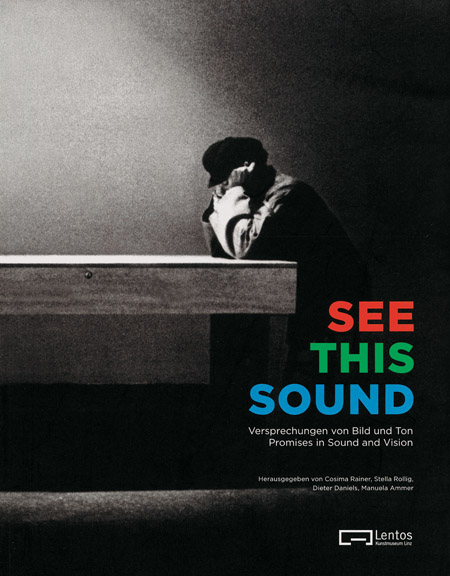See This Sound: Versprechungen von Bild und Ton / Promises in Sound and Vision (2010) [German/English]
Filed under book, catalogue | Tags: · art, art history, audiovisual, avant-garde, cassette culture, dance, electronic art, experimental film, film, fluxus, music, music history, performance, performance art, sound, sound art, synaesthesia, video, video art, vision, visual music

“As the status of sound in art and music evolves and redefines itself, so too does sound art find new ways of describing its history. See This Sound compiles a large number of artists, filmmakers, composers and performers, reaching back into the early twentieth century and into the present to survey overlaps between not only sound and art, sound and film, and the metaphor of cinema as rhythm or symphony. Proceeding chronologically, the book takes the early cinematic “eye music” of Hans Richter as a starting point, noting parallel works by Walter Ruttmann and Oskar Fischinger; moving into the postwar period, the art/cinema/ music experiments of Peter Kubelka, Valie Export and Michael Snow are discussed, establishing precedents to similar work by Rodney Graham, Carsten Nicolai, Jeremy Deller and many others.”
With essays by Helmut Draxler, Diedrich Diederichsen, Gabriele Jutz, Liz Kotz, Heidi Grundmann, Christian Höller, Dieter Daniels, and Manuela Ammer.
Edited by Cosima Rainer, Stella Rollig, Dieter Daniels and Manuela Ammer
Publisher Walther König, Cologne, 2010
ISBN 3865606830, 9783865606839
320 pages
Exhibition website and archive
PDF (19 MB, updated on 2021-7-19)
Comments (7)Vera Maletic: Body–Space–Expression: The Development of Rudolf Laban’s Movement and Dance Concepts (1987)
Filed under book | Tags: · body, choreography, dance, movement, notation, semiotics

“In May 1926, when the choreographer Rudolf von Laban came to America on an ethnographic mission to record Native American dances, a reporter accosted him before he had even stepped ashore. As Laban recounts in his autobiography, the journalist performed a wild tap dance on deck, proffered his starched cuff to the European dance artist, and said, ‘Can you write that down?’ Laban—who had pioneered a new grammar of movement called Kinetography, or script-dance—scribbled a few dance notation signs on the man’s sleeve. The hyperbolic headline announcing Laban’s arrival read: ‘A New Way to Success. Mr. L. Teaches How to Write Down Dances. You Can Earn Millions With This.’ One entrepreneur, tempted by that prospect, tracked Laban down at his hotel and offered him a fabulous amount of money to teach the Charleston and other dances by correspondence course. Laban spurned the get-rich-quick scheme: he did not want to be a part of what he dismissed as ‘robot-culture.’
To the untrained eye, Kinetography looks esoteric and occult, but to the few who can read it the complex strips of hieroglyphs allow them to recreate dances much as their original choreographers imagined them. Dance notation was invented in seventeenth-century France to score court dances and classical ballet, but it recorded only formal footsteps and by Laban’s time it was largely forgotten. Laban’s dream was to create a ‘universally applicable’ notation that could capture the frenzy and nuance of modern dance, and he developed a system of 1,421 abstract symbols to record the dancer’s every movement in space, as well as the energy level and timing with which they were made. He hoped that his code would elevate dance to its rightful place in the hierarchy of arts, ‘alongside literature and music,’ and that one day everyone would be able to read it fluently.” (from Christopher Turner’s essay in Cabinet magazine, 2009/10)
The intent of this present study is to offer an examination of the origins and development of Laban’s key concepts.
Publisher Mouton de Gruyter, Berlin/New York/Amsterdam, 1987
Volume 75 of Approaches to Semiotics
ISBN 3110107805, 9783110107807
265 pages
via joandleefe
Review (Valerie Preston-Dunlop, Dance Research, 1988)
PDF (40 MB)
See also works on Laban on Monoskop wiki.
Comment (0)Sally Banes: Terpsichore in Sneakers: Post-Modern Dance (1980/87)
Filed under book | Tags: · 1960s, 1970s, body, choreography, dance, theatre

“Sally Banes writes criticism with a dancer’s feel for dancing, a personal acquaintance with the choreographers she writes about, a solid knowledge of critical theory, and an awareness of the many relationships of post-modernism to the contemporary cultural context. Terpsichore in Sneakers is a first-rate contribution to our post-modern dance.
Banes restricts her discussion to ten choreographers: six members of Robert Dunn’s 1960-62 composition workshop (Yvonne Rainer, Steve Paxton, Trisha Brown, David Gordon, Deborah Hay, Simone Forti), all but the last of whom were early members of the Judson Dance Theater, three second-generation Judson choreographers (Meredith Monk, Kenneth King, Lucinda Childs), and Doug Dunn, who performed with Rainer, Paxton, Brown, and Gordon in the Grand Union.” (from the review by Milton H. Snoeyenbos, The Journal of Aesthetics and Art Criticism, 1980)
Originally published by Houghton Mifflin, Boston, 1980
Publisher Wesleyan University Press, 1987
With a new Introduction
ISBN 0819561606
311 pages
Commentary (André Lepecki, Dance Theatre Journal, 1999)
EPUB
See also films and videos in UbuWeb’s dance section

